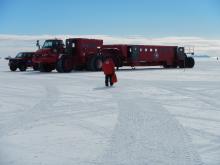What Are They Doing?
 Dry soils of the McMurdo Dry Valleys, Antarctica
Dry soils of the McMurdo Dry Valleys, Antarctica
It's hard to imagine that anything could live in the cold, dry soils of Antarctica. Early investigations of the soil bacterial communities of the McMurdo Dry Valley found only a handful of bacteria, leading to the conclusion that these soils were essentially sterile. The idea that microorganisms can grow at all in the very dry soils of the McMurdo Dry Valleys seems astounding but the recent use of advanced molecular biology techniques to investigate soil biodiversity has revealed a surprising bacterial richness in the area.
The goal of this project was to identify active members of the McMurdo Dry Valley soil microbial community and determine their ecological role. Little is known about bacterial populations in the Dry Valley soils, but until it is understood which populations are active and what they do, it is impossible to understand the ecological role that bacteria play in ecosystem function.
Where Are They?
 McMurdo Dry Valleys, Antarctica
McMurdo Dry Valleys, Antarctica
The team worked in the Dry Valleys of Antarctica and used helicopters to access their field sites. The McMurdo Dry Valleys are located on the western coast of McMurdo Sound and form the largest relatively ice-free area on the Antarctic continent. The perennially ice-covered lakes, frozen alpine glaciers, and extensive areas of exposed soil and permafrost within the McMurdo Dry Valleys are subject to low temperatures, limited snowfall, and salt accumulation.
Latest Journals

Egbert Schwartz is a soil microbiologist. He received his undergraduate degree in botany at Michigan State University, went on to complete a master's degree in cellular and molecular biology at the University of Michigan and a PhD in soil ecology at the University of California Davis. He specializes in using molecular biological techniques to characterize microorganisms in soil. Specifically, he investigates which microbial populations are growing and which microbial populations are dormant.
Dr. Schwartz has been active in science outreach to the local schools for about 10 years. He has done laboratory experiments with elementary school students in Flagstaff and in the Hopi nation, given presentations in high school classes and has trained both middle school and high school teachers by involving them in his laboratory research.




